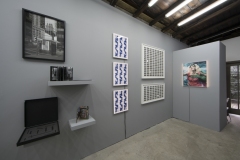a decade of public interventions by Jordan Seiler

| SPECIAL EVENT: PARASITE – A Negotiation of the Public’s Space A Panel Discussion at Postmasters Gallery with Jordan Seiler, Karen Wong, Nick Colvin, and Aymann Ismael Sunday, October 24th, 4-6 PM Postmasters Gallery 54 Franklin Street New York, NY 10013 Auxiliary Projects is pleased to present a micro museum survey of works by Jordan Seiler. Seiler’s practice is a brand of austere conceptualism that focuses on the materials presented to city dwellers as visual terrain. Deploying a “nose to tail” approach, he reshapes the (stolen) materials of commercial advertising and delivers them back to us in elegant packages devoid of their original messaging. For Seiler, who studied Photography at RISD and is a born and raised New Yorker, this work has meant survival: a way to contend with the sheer volume of visual stimulation he encounters on a daily basis while moving through his routine, and a strategic response to the paid ads intent on altering public behavior for private profit. In an activist modality, Seiler’s artistic interventions into the urban commercial landscape critique how modern life is constructed by corporate entities and explore methods for a city’s inhabitants to push back on those constructions to forge their own realities. To manifest these negotiations into works of art Seiler has used several approaches, ranging from activist vandalism to sanctioned public projects to individual unique art works. This exhibition includes sculptures composed of pilfered advertising infrastructure, documentation of public interventions, and augmented reality works–all of which represent the tip of the very large iceberg of Seiler’s practice. In the 1960s the longtime New York City resident and pioneering sound artist John Cage wrote about the positive emotional effect his sound works could have on listeners. Cage believed that listening to one of his performances could alter the way an audience member would react to the sounds of their surroundings, allowing them to suddenly hear “unsuspected beauty in their everyday life.” With a similar motivation, Seiler has offered projects in the streets and in the studio intended to offer the viewer pause in future encounters with commodified public space. He views the artist’s role as facilitating broader participation in the city as collaborator rather than consumer, and his work insists that we are all part of an ongoing, back-and-forth negotiation with our cities: parasites in need of one another. |










